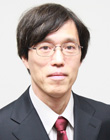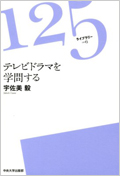Top>Opinion>The Magic of NHK’s Asadora
 Index
Index

Takeshi Usami [profile]
The Magic of NHK’s Asadora
Takeshi Usami
Professor of Modern Literature, Faculty of Letters, Chuo University
Area of Specialization: Modern Japanese Literature
Researching TV Drama
My field of research broadly encompasses modern literature, including the works of Haruki Murakami, and comprehensive research into fiction spanning theater, movies and TV drama series. I have tended to emphasize on TV drama series among these, since this is a genre enjoyed by a larger number of people compared to the other fields and, as such, I believe they reflect the state of mind of people living in today’s society.
The same can be said of manga and anime. I was often scolded as a child to “stop reading manga all the time and study.” But today, manga and anime have been regarded outside of Japan as representing Japanese culture, to the extent that it is no longer possible to consider Japanese culture without including them. Despite this fact, at universities and in the academic world, the prejudice still remains of considering manga as simply “entertainment” and similarly TV drama series as "low culture." However, when comprehensively thinking about modern culture, we cannot exclude from the target of research a media that draws and attracts such large numbers of people.
The Special Asadora
I recently contributed a series of articles to the Nikkei newspaper on the subject of NHK’s Serial TV Novels, or Asadora (meaning "morning drama") in the Culture column of the evening edition, every Thursday in March 2014. Therefore, I would like to capture Asadora in this article.
The Asadora, which is a TV drama series showing every morning for just 15 minutes every day, is quite unusual elsewhere in the world. In Korea, there are several slots for certain drama series lasting 30 minutes every morning, but they are longer than the Asadora in Japan and many viewers watch several programs in a row.
Looking historically, the viewing rate of TV drama series is in a downward trend. There is an increasing diversity in entertainment, such as internet and games, and now people can easily obtain most information they desire. So among some researchers and critics the opinion has emerged that continuing to watch Asadora for just 15 minutes every day or watching a drama series on a commercial TV station once a week is a form that is out of date. According to this opinion, the form of viewing a show at a set time is becoming obsolete, and in the future, this will be completely replaced by the internet “on-demand” form of viewing.
However, since Asadora and other TV drama series seem to have regained some of their vigor in recent years, this sort of prediction may not necessarily be correct.
Lifestyle Created by Inconvenience
In the fall of last year, a strange phrase, “Ama-loss,” became popular in Japan. It describes the sense of loss that fans felt after the Ama-chan drama series ended. This phrase also conveys a sense of how Asadora is not just an entertainment or leisure pursuit, but actually a part of daily life, or a kind of daily routine. In fact, to people who became glued to Ama-chan, they watched this Asadora before going to work or after seeing off their husband in the morning, or watched a recording of it after returning from work, and watching it every day had become a part of their daily lives. This routine had been so firmly embedded in their daily life that the rhythm of their lifestyles stopped functioning properly after losing it.
From this point of view, one can begin to understand the reason for accepting the extreme “inconvenience” of only being able to watch 15 minutes a day in this modern age when any sort of information can be obtained conveniently. The format of Japanese Asadora is one of realizing in its highest form the paradox of something being “essential to daily life because it is inconvenient.”
Meeting the Same People Every Day
Another important aspect is that the Asadora does not necessarily rush forward at breakneck pace. In contrast to shows where some episodes commonly make you want to see the next part quickly, the Asadora is not necessarily like this. If it was, the show would include more dramatic events more frequently and viewers could not possibly be satisfied with just seeing 15 minutes a day.
However, the Asadora allows the viewer to “meet the same people every day.” In this sense, it is close to meeting one’s homeroom teacher in the classroom every morning or having a meeting with supervisors and colleagues going over the tasks of the day. They have the important role of helping people to prepare their state of mind for going to classes or doing their work each day. Or perhaps watching the Asadora acts as a cue for evening viewers to switch back to being themselves, as they return to their private lives after being at work.
It is for this reason that the important element in Asadora is not “events” but “people.” It responds to a need to see a bright smile in the morning, to cheer you up and make you feel ready to face the day at work in good humor, or a warm grin to welcome you back from work and help you relax. The Asadora does not need superwomen or master detectives as their heroines.
The Heroines of Asadora
In this sense, Gochisosan, which was broadcast until last month, was a typical Asadora. Rather than focusing on dramatic developments, coming into contact with the sentiments of a main character who lives to hear words of gratitude from other people brightened up the daily lives of viewers.
Looking back, the Asadora have portrayed a wide variety of heroines. While some have been portrayed taking on the challenge of professions in which women are traditionally rare, such as lawyers, Japanese chess players, carpenters, Japanese sweet-makers, Japanese cooks, rakugo storytellers and doctors, there have also been women who may not take center stage but who cast a bright light on those around them. They are all the sort of heroines that viewers would like to “meet every day.”
In the current Asadora is Hanako and Ann, in which scriptwriter Miho Nakazono portrays the life of the translator, Hanako Muraoka. Nakazono wrote a famous work on The Dignity of a Temporary Worker [Haken no Hinkaku], a modern drama series broadcast on a commercial TV station which portrayed the relation between women and their work. Using its very long time frame, this Asadora will describe the heroine’s awakening to the world of stories and the orbit of her development as a translator.
However long ago the period in which these women are portrayed, the Asadoras continue to demonstrate its magic.
- Takeshi Usami
Professor of Modern Literature, Faculty of Letters, Chuo University
Area of Specialization: Modern Japanese Literature -
Professor Usami was born in Tokyo in 1958 and graduated with an undergraduate degree in Education from Tokyo Gakugei University. After completing credits in the Doctoral Program at the Graduate School in the Division of Humanities at the University of Tokyo in 1990, Usami earned a PhD in Literature from Chuo University. Usami served in various posts including Lecturer and Assistant Professor in the Department of Literature at Chuo University before assuming his current position in 1998.

Academic Study of TV Drama Shows [Terebi Dorama wo Gakumon suru]
Usami have examined modern literature, beginning with Haruki Murakami, from an historical perspective and located it in the history of novels after the Meiji Period. Recently he is proposing comprehensive fiction studies which include not only literature but also plays, and particular emphasis on TV drama shows.
His primary works include Modernity as Fictional Expression [Shosetsu Hyogen toshite no Kindai] (Ohfu), and collaborations as coeditor of Haruki Murakami and the Eighties [Haruki Murakami to 1980 Nendai] and Haruki Murakami and the Nineties [Haruki Murakami to 1990 Nendai] (both published by Ohfu), and Academic Study of TV Drama Shows [Terebi Dorama wo Gakumon suru] (Chuo University Press), among others. . - His faculty homepage can be found at http://c-faculty.chuo-u.ac.jp/~usami/index.html

- Research Activities as a Member of Research Fellowship for Young Scientists (DC1), Japan Society for the Promotion of Science (JSPS) Shuma Tsurumi
- Important Factors for Innovation in Payment Services Nobuhiko Sugiura
- Beyond the Concepts of Fellow Citizens and Foreigners— To Achieve SDGs Goal 10 “Reduce Inequality Within and Among Countries” Rika Lee
- Diary of Struggles in Cambodia Fumie Fukuoka
- How Can We Measure Learning Ability?
—Analysis of a Competency Self-Assessment Questionnaire— Yu Saito / Yoko Neha - The Making of the Movie Kirakira Megane








